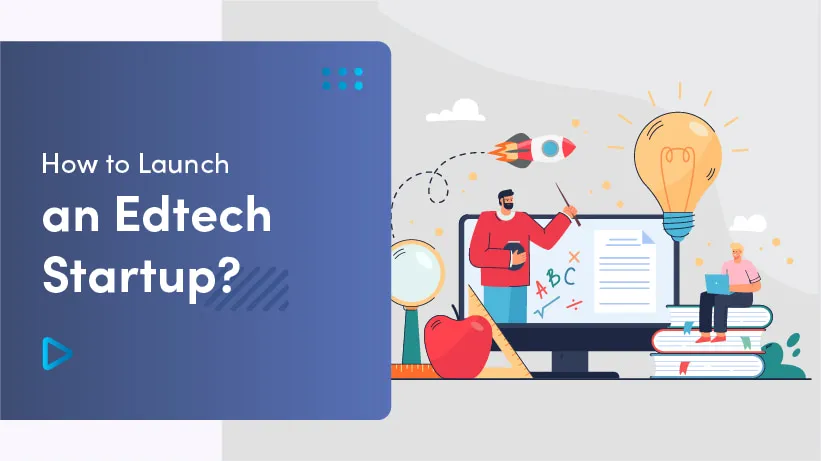Started as an experiment in the ’60s by a professor at Stanford University, the basic idea was to teach arithmetic and spelling to elementary high school students using computers. At that time, the internet was not even introduced. Six decades passed now, and the concept of educating students using the internet, modern devices, and highly sophisticated software, is taking over the world by storm.
EdTech is changing the education material from books to digital content. In fact, it is enhancing the old education system by improving the pedagogy and learning process that ultimately results in enhancing the education system.
Now the question arises if it is an excellent time to start an EdTech Company.
What will you learn from this article:
- How does EdTech enhance traditional pedagogical methods and learning outcomes?
- What are some unexplored opportunities in the EdTech market that new startups could capitalize on?
- What are the common funding methods for starting an EdTech company, and what are their pros and cons?
- How important is it for EdTech startups to focus on high-quality content and rigorous beta testing?
- What are some of the main reasons EdTech startups fail, and how can these pitfalls be avoided?
- In what ways can EdTech startups ensure they remain competitive and relevant in a rapidly evolving market?
Will it be Profitable to Start an EdTech Company?
The global EdTech Investment in 2017 reached skyrocketing $9.5 billion, funding 813 Education Technology Companies Looking at the massive growth in the EdTech industry, many investors lured to initiate startups. In 2018 EdTech shattered its previous records with $8.24 billion in investment in the first six months of the year. It receives total funding of starting up 437 new companies.
Do you know that the global EdTech and e-learning market is projected to grow at 5.08% CAGR by 2022? If you don’t, you should also know that the revenue from EdTech is expected to be a whopping 243 billion dollars.
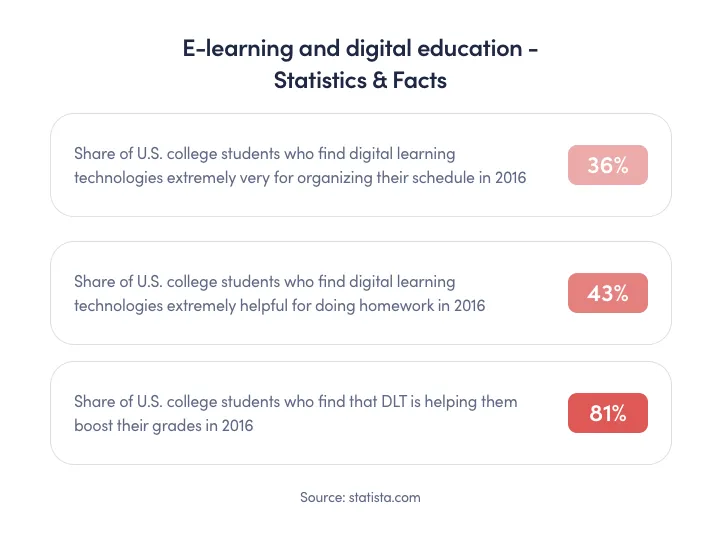
EdTech companies seem to fit in the Uber and Airbnb shoes to be the next unicorn startups. China-based education startup Yuanfudao is reported to raise a whopping $250 million from Tencent. Another EdTech company in India, BYJU, is in talks to raise $200-300 million in funding from General Atlantic and Temasek Holdings.
The reason for this exponential growth is the high demand of EdTech. The popularity of EdTech has increased after the COVID-19 Pandemic hit the world. Major universities shifted their classes from traditional classrooms to online courses.
EdTech's target audience is not limited to the education sector only, but it is also used for corporate learning in large corporations. These professionals have surged the demand for reskilling and online certificate categories.
There is a huge opportunity in the EdTech market, and it is a good time to penetrate. If you are looking to start an EdTech startup, you should read this article till the end.
What is EdTech?
Edtech is the practice of introducing IT tools into the classroom to create a more engaging, inclusive, and individualized learning experience. Modern EdTech includes LMS’, learning platforms, mobile educational apps, webinar services, authoring tools, and more.
Investopedia defines it as:
“EdTech refers to software designed to enhance teacher-led learning in classrooms and improve students’ education outcomes. EdTech is in the early stages of development. Still, it shows promise as a method of customizing the curriculum for a student’s ability level by introducing and reinforcing new content at a pace the student can handle. EdTech is a portmanteau of “education” and “technology.”
Try our developers.
Free for 2 weeks.
No risk. Just results. Get a feel for our process, speed, and quality — work with our developers for a trial sprint and see why global companies choose Selleo.
6 Reasons to Launch an EdTech Startup
If you are an entrepreneur, the first and foremost important reason you start an EdTech company is to earn profits. Keeping business aside, there are many reasons that an existing IT company or Software house can launch an EdTech startup.
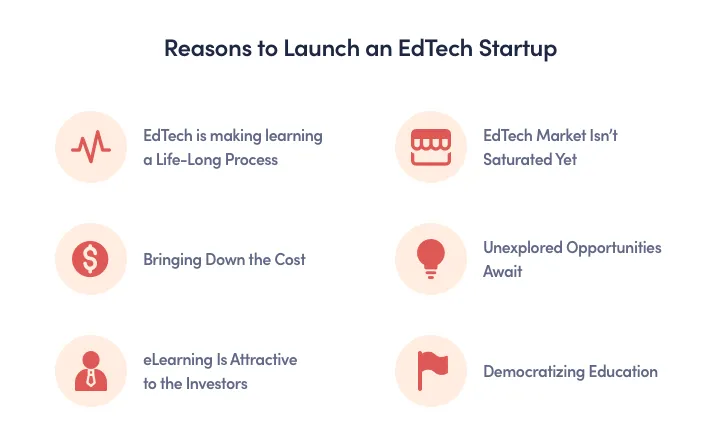
#1: EdTech is making learning a Life-Long Process
According to a Speak-up yearly survey conducted to determine the role of technology in education, 72% of schools use cloud technology, 57% allows their student to use mobile devices in class, and 48% provide online courses.
EdTech is making learning a life-long process and is very important for learners of any age.
We go to school and then as college students, college to get an education to apply it to the workplace. Well, this concept is getting obsolete. The process of learning is not something that should be left just after completing school or college education. Now, it is a never-ending process. In fact, in this rapidly changing technological era, it becomes crucial to keep on updating your skill sets irrespective of age.
Top companies are promoting the culture of life-long learning such as Deloitte, PwC, Wal-Mart, and others. They use eLearning tools to train their employees from their first day at work until their entire professional career.
As there is a need for EdTech solutions for governmental and private organizations, which an EdTech company can fulfil.
#2: EdTech Market Isn’t Saturated Yet
The scope of education is increasing rapidly worldwide, and it is expected to reach a whopping USD 8 trillion market. Digital learning around the world is yet underfunded, with only 3% of funding going its way. The number shows that the market is far from being saturated. If a company is determined enough, it can obtain a perfect share in the market. Angel.co, a startup platform, shows over 21,000 educational companies, increasing from 16,000 in just two years.
#3: Bringing Down the Cost
Traditional ways of education have become expensive over a period of time. It impacted the cost to go high and impacted the environment as well.
According to research conducted by the US Bureau of Labor Statistics, a textbook's cost rose by 88% between 2006 and 2016. The increase is even higher than the tuition fees and housing cost, i.e., 63% and 50%, respectively.
EdTech has provided the world with a solution to save this cost. Digital books not only saves cost on publishing but also allow far-reaching distribution among learners. Moreover, digital educational resources come in handy to be updated or revised when needed. EdTech has also saved the transportation cost of students.
It is also very reasonable to open an EdTech startup. With the advent of open source and an increase in the number of reliable outsourcing companies, you can now have a piece of software built for a fraction of what it used to cost. Open-source solutions have decreased the expenses of building a new EdTech product by 20-50%.
#4: Unexplored Opportunities Await
Many unexplored opportunities are awaiting for companies to grab. Let’s have a look at some of them.
Gamification is a hot topic in the eLearning industry. However, it has not been fully utilized yet and still needs to be explored more. We should also mention the social learning theory, which states that learning is a cognitive process that takes place in a social context. Learning occurs through observation and direct instruction, meaning people learn better while observing the actions of others.
Overall, there are many niches your newly started company can fill and many trending technologies that you can use to compete in the market.
#5: eLearning Is Attractive to the Investors
The venture capitalists have heavily started investing in the EdTech industry. As the amount of investment grows, the number of deals declined. It means the VCs are pickier about the startups they want to invest in. Seeking assistance from an incubator or accelerator might be a good idea in such a scenario.
#6: Democratizing Education
One of the non-monetizing advantages of EdTech is Democratizing education. In previous times, education is only available to the royalties, nobilities, and rich people.
EdTech has the potential to eliminate this discrimination. EdTech can provide high standard education to everyone irrespective of their societal status or location. The schools in underdeveloped African regions can have the same educational content level as any well-known educational institutions school in developed countries.
Now, let’s move on to the more important part of this article and learn how to fund an EdTech startup.
How to Fund an EdTech Startup
How to fund an EdTech startup? Well, there are a few ways to do it. None of them is easy, but each one of them has something to offer.
- 1. Financial Loans
Every bank in the world lends money to start a business. You can go to a local bank to take a loan, or you can also avail state and governmental initiatives that can make getting funds a bit easier. If you generate funds to start your EdTech Company, you will have to return the amount of loan with interest irrespective of your business's success or failure. But managing loans payment is straightforward (fixed monthly payments), the lender doesn’t have any control over your business, and the interest payments can be deducted as expenses.
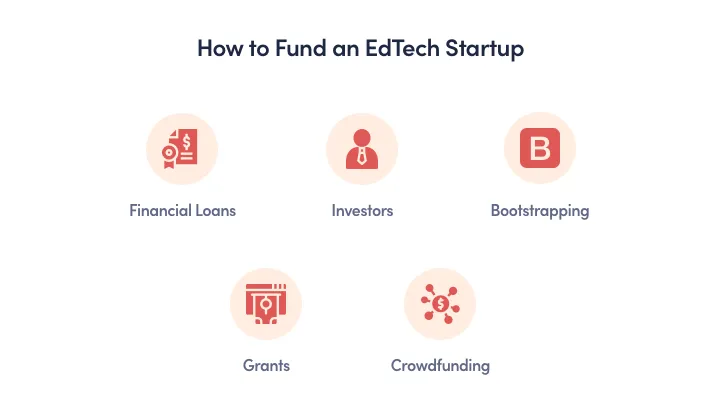
- 2. Investors
Many investors are looking for good opportunities to invest their money. They will provide you with the needed funds to start your EdTech Company in exchange for a share in your company. If an investor finds your idea viable, then he/she will definitely invest in the business. If you get investor funding, you might also get mentoring, networking, and other help. Repayments are more flexible when it comes to collecting funds via an investor, and the best part is if the startup has to close, you don’t have to give the investment money back.
Read this: what questions do investors ask startups?
- 3. Bootstrapping
Bootstrapping is the method where you will be paying to start the business with your own money. It gives you the ultimate control over all the decisions, as no one else has a share in the business. However, having such an amount can be problematic.
- 4. Grants
Education and health are the two projects for which you can find many organizations that can fund your initiative. Education is one of the very basic human rights. To provide this right to people worldwide, many national and interaction organizations can provide you with needed funds in the form of ‘Grants.’ You don’t have to pay the grants back. However, your business needs to fit the specific grant requirements.
- 5. Crowdfunding
Since 2016, Crowdfunding is a more popular method of finding funds than investments. Under this model, a large number of people contribute relatively small sums in exchange for a gift or a non-monetary bonus once the product or service is live.
EdTech Startup Best Practices
Here are some best practices that every entrepreneur should familiarize with to steer away from the competition in the market.
Know Your Niche
The first and foremost thing you should consider before starting an EdTech firm is to explore your solution statement, defining the exact problem that your product is solving. The solution statement will define your niche. It will help if you remember this: the education sector is boundless, and no one product can cater to it all.
To achieve success, you need to work long hours, take risks, and sacrifice many other aspects of your life to prepare a unique product fully. You also need to take the initiative to lead the people in your new business in the right direction.
High-Quality Content
The next step towards the success of your EdTech product is high-quality content. Not all EdTech entrepreneurs have prior experience in the education field. Therefore, it is important for them that the product must be properly defined, unique, and serve a purpose.
No one can know how incredible the features are, how attractive the UI looks, how intuitively the tool works, until or unless your content is properly served to the target audience, which is easy-to-read and understandable.
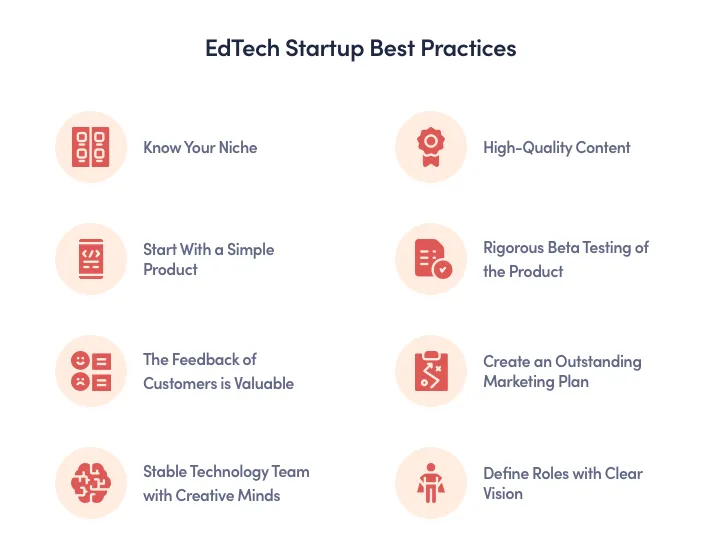
Start With a Simple Product
If it is your first time developing an EdTech product, you need to ensure that you start with a simple product using your existing strengths, unique ideas, and detailed market research to achieve success. You also need to understand that the first version of your product is not the final version. There is no such thing as a ‘Perfect Product’ that exists in the market.
You should adopt a “progress over perfection” and go-to-market approach early with a naive product rather than late with a fancy one. Once your product is out in the market, you will learn about the loopholes and improvements. It is a steep learning curve, and you will get a newer idea every day. If you want to further explore the topic, read the post How To Build A Learning Management System.
Rigorous Beta Testing of the Product
No matter how intelligent and robust your testing team is, some bugs always remain undiscovered in a testing environment. It is advisable that once the product is ready, its beta version should be distributed to the real users so they can test it in the real environment and give their valuable feedback.
Having a QA specialist is a great way to test your product. More on that topic can be found in our article Why Do We Need QA Engineers.
The Feedback of Customers is Valuable
If you want to be successful in your EdTech business, you should create ways to obtain clear feedback from your customers. You can do so by creating a report-a-problem button at critical places in the software. Never ignore feedback from any customer, collaborate with clients as much as possible. Each feedback, whether it is positive or negative, should be acknowledged warmly.
Create an Outstanding Marketing Plan
For the success of your EdTech product, you need to have a perfect marketing plan. You will need to monitor and adapt many changes every day as it is connected with the technology.
Having a clear and precise marketing plan and a dedicated budget to reach your target audience will help you develop your EdTech Company without any legal problems. Creating a great product is not enough. You need to have a diversified marketing plan to spread your marketing budget into multiple avenues. You should keep small milestones, and revisit the sales performance periodically to improvise.
Stable Technology Team with Creative Minds
No matter if you are developing the technology with a team in-house, sharing equity with a technology partner, or outsourcing a vendor, you need to ensure that you have a stable and robust team. When you have innovative and talented people, it makes it easier for the team to challenge each other’s ideas and grow together in the process.
Define Roles with Clear Vision
To successfully operate your EdTech business, you need to clarify the co-founders on the business's fundamental elements. Every team member should have defined roles and responsibilities along with a clear vision and the respective equity shares to steer away from any chaos.
EdTech startups - measuring success and planning for scaling up
In the context of an EdTech startup, measuring success and planning for scaling up are critical to ensure long-term viability and impact. Here’s a detailed look at how to approach this crucial phase:
- Establishing Key Performance Indicators (KPIs)
User Engagement - Metrics such as daily active users (DAUs), session length, and completion rates of courses or modules can indicate the value users derive from the product.
Financial Performance - Revenue, profitability, customer acquisition cost (CAC), lifetime value (LTV) of a customer, and return on investment (ROI) are essential for assessing the financial health of the startup.
Educational Outcomes - Success can also be measured by the educational impact, such as improvement in user test scores, skill acquisition, and overall satisfaction with the learning process.
- Strategies for Scaling
Geographic Expansion - Start by consolidating your presence in your current market and then gradually expanding to new regions, adapting your offerings to local educational needs and regulations.
Product Diversification - Innovate and expand your product line to include new learning tools, platforms, or subjects to cater to a broader audience.
Technology Enhancement - Invest in advanced technologies like artificial intelligence (AI), machine learning (ML), and data analytics to improve personalisation and learning outcomes, which can differentiate your product in a competitive market.
- Partnerships for Growth
Collaborations with Educational Institutions - Partnering with schools, universities, and other educational institutions can provide credibility and a direct channel to your target audience.
Corporate Partnerships - Tying up with companies for their employee training programs can open up new revenue streams.
- Customer Feedback and Iterative Improvement
Feedback Loops - Establish mechanisms to gather and analyse user feedback regularly to refine and enhance the product. This could include surveys, user forums, and direct outreach.
Iterative Development - Use agile development practices to make continuous improvements to your offerings based on user feedback and emerging educational needs.
- Maintaining Sustainability
Financial Prudence - Manage resources wisely, focusing on sustainable growth and avoiding over-expansion.
Innovation - Continually invest in research and development to keep your offerings relevant and effective.
By focusing on these areas, an EdTech startup can not only measure its current success accurately but also strategically plan for future growth and expansion, ensuring it remains competitive and relevant in the fast-evolving educational sector.
Why EdTech Startups Fail
As a startup, you will face a lot of challenges. For EdTech entrepreneurs, here are five common mistakes and how you can avoid them.
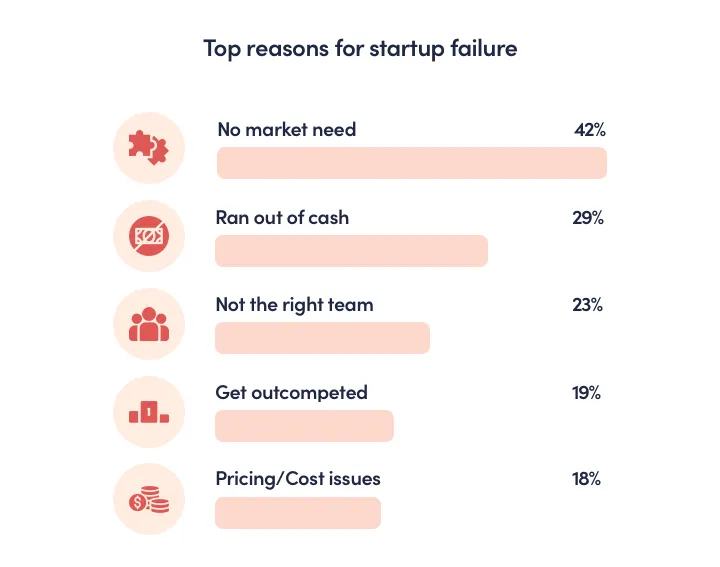
Problem# 1: Lack of Research about the Education Ecosystem
Entrepreneurs who went to public schools think they know how the education ecosystem works. Unfortunately, it is not correct. If you haven’t worked within the public education system, there is no way you can differentiate between school challenges or comprehend teacher and student needs.
Solution: Don’t assume you know everything about the needs of teachers and students. Take time to study the system and see how your product can add value to your customer. Schools are diverse where community needs vary with different cultures and demand other solutions. Entrepreneurs must conduct thorough research before starting building an EdTech firm. You should know every in and out of the education ecosystem.
Problem #2: Lack of teachers input and transparency
One of the end-users of an EdTech project are teachers. Unfortunately, teachers are rarely asked to join EdTech startups. How would you build an EdTech project without understanding how students learn, what factors influence students’ outcomes, and how does a classroom work? It is crucial to have an educator on your team.
Solution: Hire a teacher in the team for proper guidance, genuine feedback, and credibility. Market the fact that you have a certified educator onboard to create value in the product. You can also find teachers who can test your products and provide their valuable feedback on-demand at TinkerEd.
Problem #3: Arrogant Tone
Teachers and entrepreneurs are two-worlds apart. They come from uniquely different environments. Sometimes, entrepreneurs approach educators and teachers in an arrogant tone, which is highly unprofessional.
Solution: Teachers do not use the same language as entrepreneurs. Words like ‘hacking’ and ‘disrupting’ are not part of a teacher’s world and can be considered insulting. Be very thoughtful in the selection of words and choose the right tone to address educators and teachers.
Problem #4: Cold Calling and Irritating emails
To make sales, cold calling, and sending repetitive emails to teachers and educators will be considered as harassing. Your EdTech startups will earn a poor reputation in the education sector with consistent phone calls and emails—teachers make thousands of decisions every day. To them, your email or phone call is not a priority or maybe a considerable distraction in their priority work.
Solution: Invite teachers and educators on your platforms via educational content such as bogs. You should participate in Twitter tweet wars and join Facebook groups for teachers and educators to add value. You need to build an organic relationship at first without expecting profits in return. Offer free trials to teachers and educators for their feed. You can give back something as a token of your appreciation. Attend more education technology conferences and participate with teachers.
Problem #5: The motives are different, and requirements do not match
Many EdTech companies failed due to a lack of understanding of the bottom line, such as ineffective education technology; the methods are hard to understand, too expensive, or challenging to manage. The bottom line is that your product should meet the motives of teachers, parents, and students. It must benefit students, promote growth, and should be safe.
Solution: Make sure you are going to the EdTech business for the right reasons. If you are only to earn money and not focus on customer experience, you will fail. Your product should be user-oriented and not a cost-effective machine. It should be economical, as per the requirements of teachers, schools, and students.
Examples of Fail EdTech Companies
- SharpScholar is a Highly complicated product with a centralized authority system. A user needs to go through too many approvals to get access, which complicates the relationship between students and teachers and makes the process lengthy and cumbersome.
- Readmill is a company that failed due to a lack of monetization of the product.
- Shelfie is a company that failed to create a sustainable business model. According to the founder:
In the end, the unit economics of ebook sales just don't make much sense if you don't own the platform like Apple, Google, or Amazon.
Wondering How to Get Started?
Suppose you are an entrepreneur looking for an opportunity in the EdTech industry by launching your own company. In that case, it’s obvious that you’ll need e-learning software development company, a web and app development company to help you develop your dream product.
